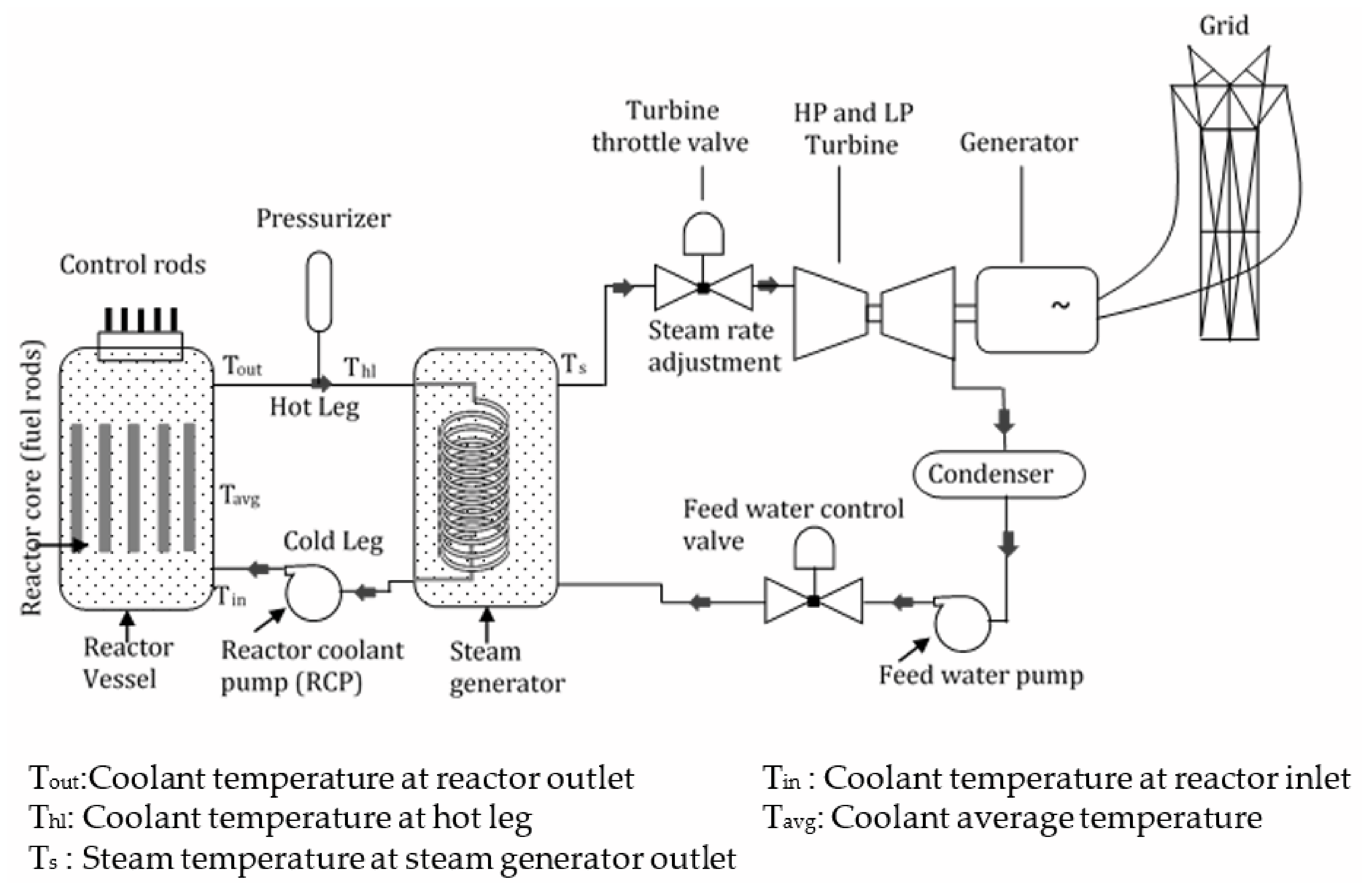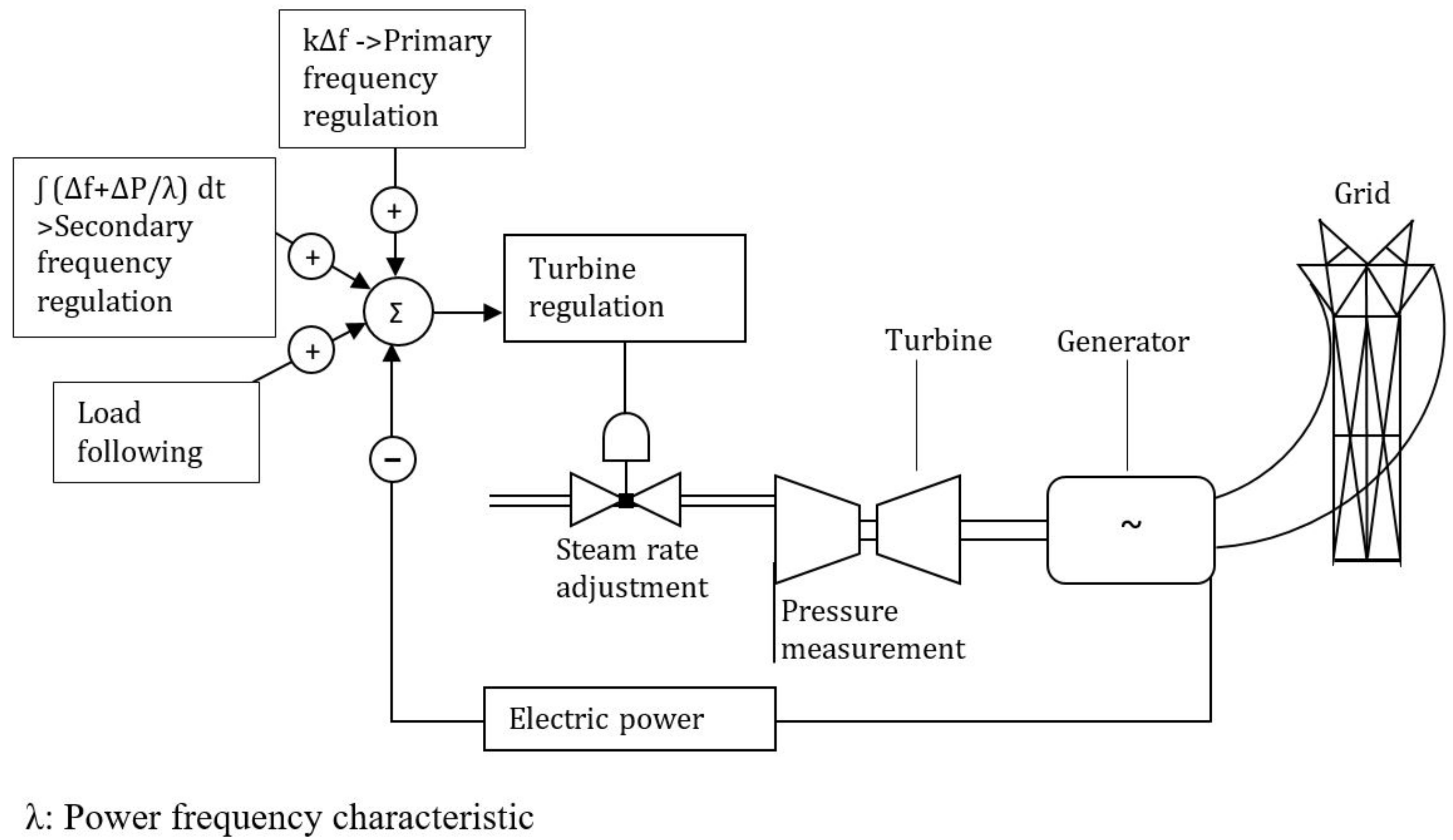Review of the Requirements for Load Following of Small Modular Reactors
Abstract
:1. Introduction
2. Overview of Small Modular Reactors
2.1. Classified by Moderator
2.2. Classified by Reaction Type
2.3. Advanced Generation IV Reactors
3. Needs and Definitions of Load-Following Operation
3.1. Increase in Variable Generation in Power Grids
3.2. Definitions and Types of Load Following
- (1)
- Load Following
- (2)
- Frequency Control
- (3)
- Voltage stability
- (4)
- European Utilities Requirements (EUR) for Load Following
4. Requirements for the Load-Following Operation of SMRs
4.1. Power Change Dependent on Grid Plans
- (1)
- Planned Operation
- (2)
- Unplanned Operation
4.2. Power Change Dependent on Frequency
- (1)
- Automatic Generation Control (AGC)
- (2)
- Governor-Free (GF) Control
4.3. Coordinated Rapid Load Following
4.4. Multi-Module Unit Operation
4.5. Cogeneration with Non-Electric Applications
5. Other Considerations for Load Following
5.1. Regulatory Requirements
- (1)
- Safety Regulations
5.2. Technical Considerations
- (1)
- Physical aspects of power regulation
- (2)
- Influence of the load following on the lifetime of components
5.3. Interaction of Grid Characteristics with Nuclear Power Plants
- (1)
- Effects of Grid Frequency Change on NPP
- (2)
- Effect of Grid Voltage Change on NPP
6. Discussion and Conclusions
Author Contributions
Funding
Institutional Review Board Statement
Informed Consent Statement
Data Availability Statement
Acknowledgments
Conflicts of Interest
Abbreviations
| AAC | Alternative AC |
| AGC | Automatic Generation Control |
| AGR | Advanced Gas-cooled Reactor |
| AVR | Automatic Voltage Regulator |
| EUR | European Utilities Requirements |
| FOAK | First of A Kind |
| FP | Full Power |
| GCR | Gas-Cooled Reactor |
| GDC | General Design Criteria |
| GF | Governor-Free |
| GFL | Grid-Following |
| GFM | Grid-Forming |
| HTGR | High-Temperature Gas-Cooled Reactor |
| HWR | Heavy Water Reactor |
| LCFR | Lead-Cooled Fast Reactor |
| LNG | Liquefied Natural Gas |
| LWR | Light Water Reactor |
| MSR | Molten Salt Reactor |
| NRC | Nuclear Regulatory Commission |
| NPP | Nuclear Power Plant |
| PPS | Preferred Power Supply |
| RES | Renewable Energy System |
| RTP | Rated Thermal Power |
| SCFR | Sodium-Cooled Fast Reactor |
| SMR | Small Modular Reactor |
| TSO | Transmission System Operator |
| VRE | Variable Renewable Energy |
References
- IAEA. Advances in Small Modular Reactor Technology Developments; A Booklet Supplement to the IAEA Advanced Reactors Information System (ARIS); IAEA: Vienna, Austria, 2020; p. 354. [Google Scholar]
- Kuznetsov, A.L.V. Current Status, Technical Feasibility and Economics of Small Modular Reactors; OECD: Paris, France, 2011. [Google Scholar]
- International Atomic Energy Agency. Technology Roadmap for Small Modular Reactor Deployment; NR-T-1.18; International Atomic Energy Agency: Vienna, Austria, 2021. [Google Scholar]
- Zohuri, B. Small Modular Reactors as Renewable Energy Sources; Springer: Cham, Switzerland, 2019. [Google Scholar]
- IAEA. IAEA-TECDOC-1972 Benefits and Challenges of Small Modular Fast Reactors; IAEA: Vienna, Austria, 2021. [Google Scholar]
- IRENA. Renewable Capacity Statistiques De Capacité Estadísticas De Capacidad; IRENA: Abu Dhabi, United Arab Emirates, 2022. [Google Scholar]
- U.S. Energy Information Administration. Administration. International Electricity Data. Available online: https://www.eia.gov/international/data/world (accessed on 12 July 2022).
- Kroposki, B.; Johnson, B.; Zhang, Y.; Gevorgian, V.; Denholm, P.; Hodge, B.M.; Hannegan, B. Achieving a 100% Renewable Grid: Operating Electric Power Systems with Extremely High Levels of Variable Renewable Energy. IEEE Power Energy Mag. 2017, 15, 61–73. [Google Scholar] [CrossRef]
- Pierre, I.; Lorubio, G. Flexible Generation: Backing Up Renewables; Union of the Electricity Industry-EURELECTRIC Depot legal: D/2011/12.105/47; RESAP: Paris, France, 2011. [Google Scholar]
- Bose, D.; Hazra, A.; Mukhopadhyay, S.; Gupta, A. A Co-ordinated Control Methodology for Rapid Load-Following Operation of a Pressurized Water Reactor Based Small Modular Reactor. Nucl. Eng. Des. 2020, 367, 110748. [Google Scholar] [CrossRef]
- Nuclear Energy Agency. Technical and Economic Aspects of Load Following with Nuclear Power Plants; NEA, OECD: Paris, France, 2011; pp. 1–51. [Google Scholar]
- IAEA (International Atomic Energy Agency). Non-Baseload Operation in Nuclear Power Plants: Load Following and Frequency Control Modes of Flexible Operation; IAEA Nuclear Energy Series; IAEA: Vienna, Austria, 2018; pp. 1–190. [Google Scholar]
- Ackermann, T.; Prevost, T.; Vittal, V.; Roscoe, A.J.; Matevosyan, J.; Miller, N. Paving the Way A Future without Inertial Is Closer Than You Think. IEEE Power Energy Mag. 2017, 15, 65–67. [Google Scholar] [CrossRef]
- Pattabiraman, D.; Lasseter, R.H.; Jahns, T.M. Comparison of Grid Following and Grid Forming Control for a High Inverter Penetration Power System. In Proceedings of the 2018 IEEE Power & Energy Society General Meeting (PESGM), Portland, OR, USA, 5–10 August 2018; pp. 1–5. [Google Scholar]
- Bruynooghe, C.; Eriksson, A.; Fulli, G. Load-Following Operating Mode at Nuclear Power Plants (NPPs) and Incidence on Operation and Maintenance (O&M) Costs. Compatibility with Wind Power Variability; European Commission: Luxembourg, 2010. [Google Scholar]
- Peakman, A.; Merk, B.; Hesketh, K. The potential of pressurised water reactors to provide flexible response in future electricity grids. Energies 2020, 13, 941. [Google Scholar] [CrossRef]
- Ingersoll, D.T.; Colbert, C.; Houghton, Z.; Snuggerud, R.; Gaston, J.W.; Empey, M. Can Nuclear Power and Renewables be Friends? In Proceedings of the ICAPP 2015, Nice, France, 3–6 May 2015; p. 9. [Google Scholar]
- Ludwig, H.; Salnikova, T.; Waas, U. Load-following Capability of German Nuclear Power Plants (NPPs). ATW Int. J. Nucl. Power 2010, 55, 4–5. [Google Scholar]
- World Nuclear Association. Small Nuclear Power Reactors. Available online: https://www.world-nuclear.org/information-library/nuclear-fuel-cycle/nuclear-power-reactors/small-nuclear-power-reactors.aspx (accessed on 5 May 2022).
- Locatelli, G.; Boarin, S.; Fiordaliso, A.; Ricotti, M.E. Load following of Small Modular Reactors (SMR) by cogeneration of hydrogen: A techno-economic analysis. Energy 2018, 148, 494–505. [Google Scholar] [CrossRef]
- IAEA Advanced Reactors Information System. Characteristics of Advanced Reactors. Available online: https://aris.iaea.org/sites/operating.html (accessed on 7 July 2022).
- Locatelli, G.; Mancini, M.; Todeschini, N. Generation IV nuclear reactors: Current status and future prospects. Energy Policy 2013, 61, 1503–1520. [Google Scholar] [CrossRef]
- Kunitomi, K.; Yan, X.; Nishihara, T.; Sakaba, N.; Mouri, T. JAEA’S VHTR for Hydrogen and Electricity Cogeneration: GTHTR300C. Nucl. Eng. Technol. 2007, 39, 9–20. [Google Scholar] [CrossRef]
- Bickel, J.H. Grid Stability and Safety Issues Associated with Nuclear Power Plants. Evergr. Saf. Reliab. Technol. 2001, 14, 1–9. [Google Scholar]
- USNRC. Appendix A to Part 50—General Design Criteria for Nuclear Power Plants. US Nuclear Regulatory Commission. Med. Dosim. 2020, 13, 87–93. [Google Scholar]
- IEEE Std 765-1983; IEEE Standard for Preferred Power Supply (PPS) for NUclear Power Generating Stations. IEEE: New York, NY, USA, 1995. [CrossRef]
- IAEA. Design of Electrical Power Systems for Nuclear Power Plants; Specific Safety Guide, No. SSG-34; IAEA: Vienna, Austria, 2012; pp. 1–144. [Google Scholar]
- NuScale Power. Nuscale SMR Technology: An Ideal Solution for Repurposing U.S. Coal Plant Infrastructure and Revitalizing Communities; NuScale Power: Corvallis, OR, USA, 2021. [Google Scholar]
- Wenisch, A.; Becker, O. NPP Output Flexibility Expectations in the Light of Reality; Österreichisches Ökologie-Institut: Vienna, Austria, 2010. [Google Scholar]
- IAEA. Interaction of Grid Characteristics with Design and Performance of Nuclear Power Plants. A Guidebook; Technical Reports Series No. 224; International Atomic Energy Agency: Vienna, Austria, 1983. [Google Scholar]
- Chowdhury, A.H.; Rabby, M.K.M. A study on low grid voltage problem near Rooppur nuclear power plant. In Proceedings of the 8th International Conference on Electrical and Computer Engineering, ICECE, Dhaka, Bangladesh, 20–22 December 2014; pp. 289–292. [Google Scholar]
- World Bank. Tracking SDG7: The Energy Progress Report 2018; World Bank: Washington, DC, USA, 2018; p. 193. [Google Scholar]
- OECD/IEA. World Energy Model Documentation; OECD: Paris, France, 2021. [Google Scholar]


| Capacity (GW) | 2012 | 2013 | 2014 | 2015 | 2016 | 2017 | 2018 | 2019 | 2020 | 2021 |
|---|---|---|---|---|---|---|---|---|---|---|
| World | 1444 | 1566 | 1698 | 1852 | 2014 | 2185 | 2357 | 2542 | 2807 | 3064 |
| China | 302.1 | 359.5 | 414.7 | 479.1 | 541.0 | 620.9 | 695.5 | 758.8 | 899.6 | 1020 |
| India | 60.5 | 63.6 | 71.9 | 78.6 | 90.4 | 105.2 | 118.2 | 128.4 | 134.4 | 147.1 |
| Japan | 39.0 | 46.1 | 56.1 | 67.4 | 76.2 | 84.2 | 91.3 | 99.3 | 106.9 | 111.9 |
| Korea | 3.7 | 4.3 | 5.7 | 7.2 | 9.4 | 11.4 | 14.0 | 18.0 | 20.4 | 24.3 |
| Description | NPP | HC | Lign | CCG | PS |
|---|---|---|---|---|---|
| Start-up Time “Cold” | ~40H | ~6H | ~10H | <2H | ~0.1H |
| Start-up Time “warm” | ~40H | ~3H | ~6H | <1.5H | ~0.1H |
| Load Gradient (up) ”nominal output” | ~5%/M | ~2%/M | ~2%/M | ~4%/M | >40%/M |
| Load Gradient (down) ”nominal output” | ~5%/M | ~2%/M | ~2%/M | ~4%/M | >40%/M |
| Minimal Shutdown Time | No | No | No | No | ~10H |
| Minimal Possible Load | 50% | 40% | 40% | <50% | ~15% |
| Response Base | Response Mode | Parameter and Properties |
|---|---|---|
| Predicted daily demand variations | Load following | Low-power period (power level and duration) Power change rate (slow, fast) Time in cycle (beginning, end) |
| Spontaneous limited demand variations | Frequency control | Local frequency control: frequency deviation (ΔF) converted into power change (ΔP) (ΔP amplitude, slope of change) Remote frequency control: signal from the dispatcher (ΔP amplitude, slope of change) Superimposition of local and remote frequency control |
| Grid disturbances | Spinning reserve | Ramp (amplitude, slope, from minimum power level) Steps (amplitude, from minimum power level) House load capability (loss of off-site power without reactor trip) Fast (e.g., 5% rated thermal power/minute) return to full power without advance notice |
| Longer-term forecasted demand | Extended low-power operation | Reduced power level during extended period (number of occurrences, duration) |
| Common Requirements Applicable to NEW LWRs | Parameter |
|---|---|
| Continuous operation range (mandatory) | 50%~100% Pn |
| Down to minimum (option) | 20% |
| Primary control (mandatory); 2~30 s after deviation observed | ±2% Pn/min |
| Higher values by agreement between system operator and plant operator | ± 5% Pn/min |
| Activating total primary range of control requested | Within 30 s |
| Secondary control (option); several seconds to several minutes | ±10% |
| Load-Following Capabilities (option) | |
| Load-following capability until ( ) % of whole fuel cycle | 90% |
| Load-following range | 100% Pn~minimum |
| From full power to minimum load and back to full power operation | 2 per day, 5 per week Cumulatively 200 per year |
| Emergency load variation (by agreement between grid operator and unit operator); amplitude down to minimum load of the unit. | 20% of Pn/min. |
Publisher’s Note: MDPI stays neutral with regard to jurisdictional claims in published maps and institutional affiliations. |
© 2022 by the authors. Licensee MDPI, Basel, Switzerland. This article is an open access article distributed under the terms and conditions of the Creative Commons Attribution (CC BY) license (https://creativecommons.org/licenses/by/4.0/).
Share and Cite
Chang, C.-k.; Oyando, H.C. Review of the Requirements for Load Following of Small Modular Reactors. Energies 2022, 15, 6327. https://doi.org/10.3390/en15176327
Chang C-k, Oyando HC. Review of the Requirements for Load Following of Small Modular Reactors. Energies. 2022; 15(17):6327. https://doi.org/10.3390/en15176327
Chicago/Turabian StyleChang, Choong-koo, and Harold Chisano Oyando. 2022. "Review of the Requirements for Load Following of Small Modular Reactors" Energies 15, no. 17: 6327. https://doi.org/10.3390/en15176327
APA StyleChang, C.-k., & Oyando, H. C. (2022). Review of the Requirements for Load Following of Small Modular Reactors. Energies, 15(17), 6327. https://doi.org/10.3390/en15176327







